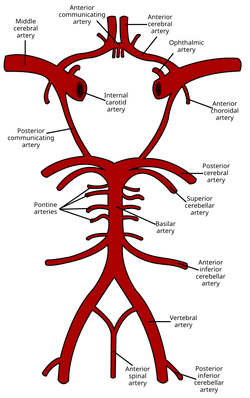No edit summary |
No edit summary |
||
| Line 22: | Line 22: | ||
==Pathology== |
==Pathology== |
||
[[Aneurysm]]s of the anterior communicating artery are the most common circle of Willis aneurysm<ref>Beck J, Rohde S, Berkefeld J, Seifert V, Raabe A. Size and location of ruptured and unruptured intracranial aneurysms measured by 3-dimensional rotational angiography. Surg Neurol. 2006 Jan;65(1):18-25; discussion 25-7. PMID 16378842.</ref> and can cause [[visual field loss|visual field defect]]s such as [[bitemporal hemianopsia]],<ref>Aoki N. Partially thrombosed aneurysm presenting as the sudden onset of bitemporal hemianopsia. Neurosurgery. 1988 Mar;22(3):564-6. PMID 3362325.</ref> [[psychopathology]] and [[frontal lobe]] pathology.<ref>Johnson MK, O'Connor M, Cantor J. Confabulation, memory deficits, and frontal dysfunction. Brain Cogn. 1997 Jul;34(2):189-206. PMID 9220085.</ref> |
[[Aneurysm]]s of the anterior communicating artery are the most common circle of Willis aneurysm<ref>Beck J, Rohde S, Berkefeld J, Seifert V, Raabe A. Size and location of ruptured and unruptured intracranial aneurysms measured by 3-dimensional rotational angiography. Surg Neurol. 2006 Jan;65(1):18-25; discussion 25-7. PMID 16378842.</ref> and can cause [[visual field loss|visual field defect]]s such as [[bitemporal hemianopsia]],<ref>Aoki N. Partially thrombosed aneurysm presenting as the sudden onset of bitemporal hemianopsia. Neurosurgery. 1988 Mar;22(3):564-6. PMID 3362325.</ref> [[psychopathology]] and [[frontal lobe]] pathology.<ref>Johnson MK, O'Connor M, Cantor J. Confabulation, memory deficits, and frontal dysfunction. Brain Cogn. 1997 Jul;34(2):189-206. PMID 9220085.</ref> |
||
| + | |||
| + | ==See also== |
||
| + | *[[Cerebral arteriosclerosis]] |
||
| + | *[[Cerebral blood flow]] |
||
| + | *[[Cerebral hemorrhage]] |
||
| + | *[[Cerebrovascular accident]] |
||
| + | *[[Cerbrovascular disorders]] |
||
==References== |
==References== |
||
Latest revision as of 15:27, 17 August 2012
Assessment |
Biopsychology |
Comparative |
Cognitive |
Developmental |
Language |
Individual differences |
Personality |
Philosophy |
Social |
Methods |
Statistics |
Clinical |
Educational |
Industrial |
Professional items |
World psychology |
Biological: Behavioural genetics · Evolutionary psychology · Neuroanatomy · Neurochemistry · Neuroendocrinology · Neuroscience · Psychoneuroimmunology · Physiological Psychology · Psychopharmacology (Index, Outline)
| Artery: Anterior communicating artery | ||
|---|---|---|
| The cerebral arterial circle and arteries of the brain. The anterior communicating arteries (top of figure) connect the left and right anterior cerebral arteries. | ||
| [[Image:{{{Image2}}}|250px|center|]] | ||
| {{{Caption2}}} | ||
| Latin | arteria communicans anterior | |
| Gray's | subject #146 572 | |
| Supplies | ||
| From | ||
| To | ||
| Vein | ||
| MeSH | [1] | |
| Dorlands/Elsevier | {{{DorlandsPre}}}/{{{DorlandsSuf}}} | |
In human anatomy, the anterior communicating artery is a blood vessel of the brain that connects the left and right anterior cerebral arteries.
The anterior communicating artery connects the two anterior cerebral arteries across the commencement of the longitudinal fissure. Sometimes this vessel is wanting, the two arteries joining together to form a single trunk, which afterward divides; or it may be wholly, or partially, divided into two. Its length averages about 4 mm, but varies greatly. It gives off some of the anteromedial ganglionic vessels, but these are principally derived from the anterior cerebral artery.
It is part of the cerebral arterial circle, also known as the circle of Willis.
Pathology
Aneurysms of the anterior communicating artery are the most common circle of Willis aneurysm[1] and can cause visual field defects such as bitemporal hemianopsia,[2] psychopathology and frontal lobe pathology.[3]
See also
- Cerebral arteriosclerosis
- Cerebral blood flow
- Cerebral hemorrhage
- Cerebrovascular accident
- Cerbrovascular disorders
References
- ↑ Beck J, Rohde S, Berkefeld J, Seifert V, Raabe A. Size and location of ruptured and unruptured intracranial aneurysms measured by 3-dimensional rotational angiography. Surg Neurol. 2006 Jan;65(1):18-25; discussion 25-7. PMID 16378842.
- ↑ Aoki N. Partially thrombosed aneurysm presenting as the sudden onset of bitemporal hemianopsia. Neurosurgery. 1988 Mar;22(3):564-6. PMID 3362325.
- ↑ Johnson MK, O'Connor M, Cantor J. Confabulation, memory deficits, and frontal dysfunction. Brain Cogn. 1997 Jul;34(2):189-206. PMID 9220085.
External links
This article was originally based on an entry from a public domain edition of Gray's Anatomy. As such, some of the information contained herein may be outdated. Please edit the article if this is the case, and feel free to remove this notice when it is no longer relevant.
List of arteries of head and neck | |
|---|---|
| Anterior: CC/EC |
superior thyroid (superior laryngeal) - lingual (sublingual) facial: cervical branches (ascending palatine, tonsillar, submental, glandular) - facial branches (inferior labial, superior labial, lateral nasal, angular) |
| Posterior and ascending: CC/EC |
occipital - posterior auricular (stylomastoid) - ascending pharyngeal (meningeal branches) |
| Terminal, superficial temporal: CC/EC |
transverse facial - middle temporal (zygomaticoörbital) - anterior auricular - frontal - parietal |
| Terminal, maxillary: CC/EC |
1st part: anterior tympanic - deep auricular - middle meningeal (superior tympanic) - accessory meningeal - inferior alveolar (mylohyoid) |
| portions #1 and 2: CC/IC |
cervical portion (carotid sinus) - petrous portion (Vidian, caroticotympanic) |
| cavernous portion/ophthalmic: CC/IC |
orbital group: lacrimal (lateral palpebral) - supraorbital - posterior ethmoidal - anterior ethmoidal - medial palpebral - supratrochlear - dorsal nasal |
| cerebral portion: CC/IC |
ACA - anterior communicating - MCA (anterolateral central) - posterior communicating - anterior choroidal - circle of Willis |
| vertebral artery: SC |
meningeal branches - posterior spinal - anterior spinal - PICA - basilar (pontine, labyrinthine, AICA, SCA, PCA) |
| thyrocervical trunk: SC |
inferior thyroid (inferior laryngeal, tracheal, esophageal, ascending cervical) - suprascapular - transverse cervical - dorsal scapular |
| This page uses Creative Commons Licensed content from Wikipedia (view authors). |
